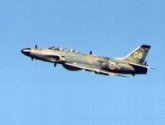
 By
1945, it was clear that future combat aircraft would be jet propelled.
We got jet fighters in 1946, in the form of Vampires, but to
find a replacement for our Saab 18 bomber was to take longer.
That project was started in 1946. The first concepts had two
de Havilland Ghost engines, with short in- and outlets. Flying
wing concepts figured, and were strong contenders, but mainly
because of accidents with foreign aircraft of that configuration,
was abandoned. Most concepts had four 20 mm cannon and an internal
rocket launcher for a dozen 15-18 cm rockets. Other armaments
was two 500 kg bombs or a missile type 303. In 1948 it was decided
to go for a smaller, single engine aircraft "project 1150".
The requirement was for an aircraft that "could carry its
weapons - guns, rockets, bombs and missiles - from a centrally
placed air base to any part of our 2000 km coast line, in under
one hour, in any weather and during darkness" In 1949 it
was awarded the designation "type 32". The name Lansen
means The Lance. By 1949, the design looked very much like what
it became, apart from the stabilizer beeing placed halfway up
on the fin. There was also a smaller, single-seat variant, which
would have been a daylight interceptor. Lansen was the first
aircraft designed in Sweden where the design work was not based
on ordinary blue-prints, but on a mathematical coordinate system.
The airframe was designed to be used up to +8G and -3G and withstand
+12G and -8G. To test a large scale model of the wing, with 35
degrees sweepback, a half-scale was mounted on a Saab Safir,
thus becoming the only Saab 202 (Saab 201 was a Safir with a
half-scale Tunnan wing). It had both Fowler flaps and a leading
edge slot. The slot was discarded as unnecessary after trials
with the prototypes and never appeared on a series aircraft.
The engine intended for Lansen was the Swedish STAL Dovern (RM
4), which was an excellent engine. It was not finished in time
for the prototypes, so a foreign engine had to be used for them.
For several reasons, Rolls-Royce Avons came to be used on the
series aircraft too. The first Lansen prototype first flew on
Nov 3:rd 1952.
By
1945, it was clear that future combat aircraft would be jet propelled.
We got jet fighters in 1946, in the form of Vampires, but to
find a replacement for our Saab 18 bomber was to take longer.
That project was started in 1946. The first concepts had two
de Havilland Ghost engines, with short in- and outlets. Flying
wing concepts figured, and were strong contenders, but mainly
because of accidents with foreign aircraft of that configuration,
was abandoned. Most concepts had four 20 mm cannon and an internal
rocket launcher for a dozen 15-18 cm rockets. Other armaments
was two 500 kg bombs or a missile type 303. In 1948 it was decided
to go for a smaller, single engine aircraft "project 1150".
The requirement was for an aircraft that "could carry its
weapons - guns, rockets, bombs and missiles - from a centrally
placed air base to any part of our 2000 km coast line, in under
one hour, in any weather and during darkness" In 1949 it
was awarded the designation "type 32". The name Lansen
means The Lance. By 1949, the design looked very much like what
it became, apart from the stabilizer beeing placed halfway up
on the fin. There was also a smaller, single-seat variant, which
would have been a daylight interceptor. Lansen was the first
aircraft designed in Sweden where the design work was not based
on ordinary blue-prints, but on a mathematical coordinate system.
The airframe was designed to be used up to +8G and -3G and withstand
+12G and -8G. To test a large scale model of the wing, with 35
degrees sweepback, a half-scale was mounted on a Saab Safir,
thus becoming the only Saab 202 (Saab 201 was a Safir with a
half-scale Tunnan wing). It had both Fowler flaps and a leading
edge slot. The slot was discarded as unnecessary after trials
with the prototypes and never appeared on a series aircraft.
The engine intended for Lansen was the Swedish STAL Dovern (RM
4), which was an excellent engine. It was not finished in time
for the prototypes, so a foreign engine had to be used for them.
For several reasons, Rolls-Royce Avons came to be used on the
series aircraft too. The first Lansen prototype first flew on
Nov 3:rd 1952.
Designations:
A, Attack = Strike
J, Jakt = Interceptor
S, Spaning = Reconnaissance
Country: Sweden
Constructor: SAAB
Function: fighter/attack
Crew: 2
Length: 14.94m
Height: 4.65m
Wing Span: 13.00m
Wing Area: 37.40m2
Max t-o weight: 13500kg
Engines: one SFA RM 6A with afterburner rated 4880 kp
Speed: 988km/h / Mach 0.93
Ceiling: 14000 m
Range: 2000km
Armament: four 20 mm cannon with 180 rnds each; rockets, free
fall bombs, Rb 04 anti-ship missile, Rb 24 Sidewinder, ECM jammer
pods